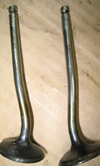Poppet valve materials
 Thus far we have examined the application of titanium in the production of racing valves, and seen how the properties of this material may be tailored to the application by either specific heat treatments, or by combining materials with different mechanical properties within the same valve by the use of friction welding. We reflected on the fact that titanium, compared to steel and most of the other materials that we would traditionally use for valve manufacture, offers a lower mass valve when properly optimised.
Thus far we have examined the application of titanium in the production of racing valves, and seen how the properties of this material may be tailored to the application by either specific heat treatments, or by combining materials with different mechanical properties within the same valve by the use of friction welding. We reflected on the fact that titanium, compared to steel and most of the other materials that we would traditionally use for valve manufacture, offers a lower mass valve when properly optimised.
There are, of course, lower density materials than titanium, although these generally have not been employed for the manufacture of racing valves. One exception to this is titanium aluminide, once a favourite of the Formula One community but, yet again, banished due to the current FIA regulations. Titanium aluminide is a material under the watchful eye of the motor manufacturers, as well as other industries. Where we might remember, not all that long ago, that titanium was very expensive, there comes a tipping point where production quantities of the material, or one particular alloy means that the price quite quickly becomes realistic. To my pleasant surprise around 10 years ago, I found that it was less expensive to source good quality titanium bolts rather than flanged stainless items. So it is with titanium aluminide – there will inevitably come a point where production quantities become sufficient that it will become economically viable for someone to put valves into a production car or motorcycle, just as happened with titanium for valves and other parts. Thankfully titanium aluminide can be used by other race series for valves, so there is some hope that racing can indeed improve the breed as far as series production engines are concerned.
Titanium aluminide was mentioned as a racing valve material in the mid to late 1990s (and possibly earlier), and was widely reported to have exceptional specific strength and specific elastic modulus combined with good high-temperature mechanical properties (it promises higher tensile strength at 760C or 1400F than it does at room temperature). Apart from commanding a high price, it seemed to offer an ideal combination of properties for a valve material. So, why was it that it took so long to become widely adopted, and why was it that it almost disappeared in short order whilst it was still legal?
The first question is certainly one of money and immaturity of technology. The material was very expensive, and titanium materials were certainly man-enough for the task. However, the properties were such that people did start to experiment with ways to make a valve which didn’t cost a ridiculous amount of money. Some of the processes used were more expensive than others, but gradually the manufacturing and processing technology matured to the point where it was viable, although still expensive, to produce Formula One valves. These valves were widely adopted at a time where Formula One engine speeds, although already high, were heading ever higher and at quite a rate of increase. Valvetrain control can be a major limiting factor in this push for higher engine speeds, and a lighter valve offers obvious advantages in this regard. So, it was that, in the quest for higher engine speeds, that titanium aluminide became widely adopted.
However, the valves made from this material seemed prone, in a small number of cases, to suffering premature failure. Where perhaps 99% of valves would happily last the required engine life, the remaining 1% could fail very early indeed, sometimes before the engine had run at full load. This situation seemed to occur after some time during which failures were rare. The material seemed to act in a brittle manner, and the failures could be quite spectacular, with large sections of the head becoming detached. The failures affected multiple teams, and emergency action was taken to put titanium valves back into action, accompanied by a consequent (and temporary) halt to the race for increased engine speeds. At the end of the same year, titanium aluminide was proscribed under the Formula One engine rules.
Written by Wayne Ward.